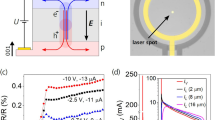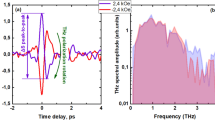Abstract
Besides adding a new functionality to conventional lasers, spin-polarized lasers can, potentially, offer lower threshold currents and reach higher emission intensities. However, to achieve spin-polarized lasing emission a material should possess a slow spin relaxation and a high propensity to be injected with spin-polarized currents. These are stringent requirements that, so far, have limited the choice of candidate materials for spin-lasers. Here we show that these requirements can be relaxed by using a new self-polarized spin mechanism. Fe3O4 nanoparticles are coupled to GaN nanorods to form an energy-band structure that induces the selective charge transfer of electrons with opposite spins. In turn, this selection mechanism generates the population imbalance between spin-up and spin-down electrons in the emitter's energy levels without an external bias. Using this principle, we demonstrate laser emission from GaN nanorods with spin polarization up to 28.2% at room temperature under a low magnetic field of 0.35 T. As the spin-selection mechanism relies entirely on the relative energy-band alignment between the iron oxide nanoparticles and the emitter and requires neither optical pumping with circularly polarized light nor electrical pumping with magnetic electrodes, potentially a wide range of semiconductors can be used as spin-nanolasers.
This is a preview of subscription content, access via your institution
Access options
Subscribe to this journal
Receive 12 print issues and online access
$259.00 per year
only $21.58 per issue
Buy this article
- Purchase on Springer Link
- Instant access to full article PDF
Prices may be subject to local taxes which are calculated during checkout






Similar content being viewed by others
References
Datta, S. & Das, B. Electronic anlog of the electro-optic modulator. Appl. Phys. Lett. 56, 665–667 (1990).
Prinz, G. A. Magnetoelectronics. Science 282, 1660–1663 (1998).
Awschalom, D. D., Samarth, N. & Loss, D. Semiconductor Spintronics and Quantum Computation (Springer, 2002).
Hallstein, S. et al. Manifestation of coherent spin precession in stimulated semiconductor emission dynamics. Phys. Rev. B 56, R7076–R7079 (1997).
Rudolph, J. et al. Room-temperature threshold reduction in vertical-cavity surface-emitting lasers by injection of spin-polarized electrons. Appl. Phys. Lett. 87, 241117 (2005).
Gothgen, C. et al. Analytical model of spin-polarized semiconductor lasers. Appl. Phys. Lett. 93, 042513 (2008).
Holub, M. & Bhattacharya, P. Spin-polarized light-emitting diodes and lasers. J. Phys. D 40, 179–203 (2007).
Holub, M. & Jonker, B. T. Threshold current reduction in spin-polarized lasers: role of strain and valence-band mixing Phys. Rev. B 83, 125309 (2011).
Basu, D. et al. Electrically injected InAsGaAs quantum dot spin-laser operating at 200K. Appl. Phys. Lett. 92, 091119 (2008).
Hovel, S. et al. Optical spin manipulation of electrically pumped vertical-cavity surface-emitting lasers Appl. Phys. Lett. 92, 041118 (2008).
Basu, D., Saha, D. & Bhattacharya, P. Optical polarization modulation and gain anisotropy in an electrically injected spin-laser. Phys. Rev. Lett. 102, 093904 (2009).
Li, M. Y. et al. Birefringence controlled room-temperature picosecond spin dynamics close to the threshold of vertical-cavity surface-emitting laser devices. Appl. Phys. Lett. 97, 191114 (2010).
Gerhardt, N. C. et al. Ultrafast spin-induced polarization oscillations with tunable lifetime in vertical-cavity surface-emitting lasers. Appl. Phys. Lett. 99, 15117 (2011).
Boéris, G., Lee, J., Výborný, K. & Žutić, I. Tailoring chirp in spin-lasers. Appl. Phys. Lett. 100, 121111 (2012).
Jonker, B. T. Progress toward electrical injection of spin-polarized electrons into semiconductors. IEEE Proc. 91, 727–740 (2003).
Blackmond, D. G. The origin of biological homochirality. Phil. Trans. R. Soc. B 366, 2878–2884 (2011).
Awschalom, D. D., Warnock, J. & von Molnár, S. Low-temperature magnetic spectroscopy of a dilute magnetic semiconductor. Phys. Rev. Lett. 58, 812–815 (1987).
Gerhardt, N. C. et al. Electron spin injection into GaAs from ferromagnetic contacts in remanence. Appl. Phys. Lett. 87, 032502 (2005).
Oestreich, M. et al. Spin injection, spin transport and spin coherence. Semicond. Sci. Technol. 17, 285–297 (2002).
Chen, W. M. et al. Efficient spin relaxation in InGaN/GaN and InGaN/GaMnN quantum wells: an obstacle to spin detection. Appl. Phys. Lett. 84, 192107 (2005).
Buyanova, I. A. et al. On the origin of spin loss in GaMnN/InGaN light-emitting diodes. Appl. Phys. Lett. 84, 2599–2601 (2004).
Fujino, H. et al. Circularly polarized lasing in a (110)-oriented quantum well vertical-cavity surface-emitting laser under optical spin injection. Appl. Phys. Lett. 94, 131108 (2009).
Satoshi, I., Shinji, K., Kazuhiro, I. & Hitoshi, K. Room temperature circularly polarized lasing in an optically spin injected vertical-cavity surface-emitting laser with (110) GaAs quantum wells. Appl. Phys. Lett. 98, 081113 (2011).
Hu, G. & Suzuki, Y. Negative spin polarization of Fe3O4 in magnetite/manganite-based junctions. Phys. Rev. Lett. 89, 276601 (2002).
Akira, Y. & Noriaki, H. Electronic structure in high temperature phase of Fe3O4 . J. Phys. Soc. Jpn 68, 1607–1613 (1999).
Tang, J., Myers, M., Bosnick, K. A. & Brus, L. E. Magnetite Fe3O4 nanocrystals: spectroscopic observation of aqueous oxidation kinetics. J. Phys. Chem. B 107, 9501–7506 (2003).
Žutić, I., Jaroslav, F. & Das S. D. Spin-polarized transport in inhomogeneous magnetic semiconductors: theory of magnetic/nonmagnetic p–n junctions. Phys. Rev. Lett. 88, 066603 (2002).
Rinaldi, C. et al. Ge-based spin-photodiodes for room-temperature integrated detection of photon helicity. Adv. Mater. 24, 3037–3041 (2012).
Puttisong, Y. et al. Efficient room-temperature spin detector based on GaNAs. J. Appl. Phys. 111, 07C303 (2012).
Michael, E. L., Sergey, L. R. & Michael, S. S. Properties of Advanced Semiconductor Materials: GaN, AIN, InN, BN, SiC, SiGe (John Wiley & Sons, 2001).
Alvarado, S. F. et al. Observation of spin-polarized electron levels in ferrites. Phys. Rev. Lett. 34, 319–322 (1975).
Morton, S. A. et al. Spin-resolved photoelectron spectroscopy of Fe3O4 . Surf. Sci. 513, L451–L457 (2002).
Fonin, M. et al. Surface electronic structure of the Fe3O4(100): evidence of a half-metal to metal transition. Phys. Rev. B 72, 104436 (2005).
Casey, H. C. et al. Low interface trap density for remote plasma deposited SiO2 on n-type GaN. Appl. Phys. Lett. 68, 1850–1852 (1996).
Camphausen, D. L., Coey, J. M. D. & Chakraverty, B. K. One-electron energy levels in Fe3O4 . Phys. Rev. Lett. 29, 657–660 (1972).
Kouno, T., Kishino, K. & Sakai, M. Lasing action on whispering gallery mode of self-organized GaN hexagonal microdisk crystal fabricated by RF-plasma-assisted molecular beam epitaxy. IEEE J. Sel. Top. Quant. Electron 47, 1565–1570 (2011).
Chen, R., Ling, B., Sun, X. W. & Sun, H. D. Room temperature excitonic whispering gallery mode lasing from high-quality hexagonal ZnO microdisks. Adv. Mater. 23, 2199–2204 (2011).
Wei, C. M., Shih, H. Y., Chen, Y. F. & Lin, T. Y. Optical detection of magnetoelectric effect in the composite consisting of InGaN/GaN multiple quantum wells and FeCo thin film. Appl. Phys. Lett. 98, 131913 (2011).
Gohda, Y. & Oshiyama, A. Intrinsic ferromagnetism due to cation vacancies in Gd-doped GaN: first-principles calculations. Phys. Rev. B 78, 161201 (2008).
Chen, H. M., Chen, Y. F., Lee, M. C. & Feng, M. S. Yellow luminescence in n-type GaN epitaxial films. Phys. Rev. B 56, 6942–6946 (1997).
Evgeny, Y. T. & Zutic, I. Handbook of Spin Transport and Magnetism (CRC Press, 2011).
Žutić, I., Fabian, J. & Das Sarma, S. Spintronics: fundamentals and applications. Rev. Mod. Phys. 76, 323–410 (2004).
Chen, J. Y. et al. Efficient spin-light emitting diodes based on InGaN/GaN quantum disks at room temperature: a new self-polarized paradigm. Nano Lett. 14, 3130 (2014).
Liao, C. H. et al. Geometry and composition comparisons between c-plane disc-like and m-plane core-shell InGaN/GaN quantum wells in a nitride nanorod. Opt. Express 20, 15859–15871 (2012).
Wu, S. H. et al. PEGylated silica nanoparticles encapsulating multiple magnetite nanocrystals for high-performance microscopic magnetic resonance angiography. J. Biomed. Mater. Res. 98B, 81–88 (2011).
Acknowledgements
This work was supported by the National Science Council and the Ministry of Education of the Republic of China. We thank W. Chen and C-Y. Mou for providing the Fe3O4 nanoparticles, and C-H. Liao and C-C. Yang for the fabrication of GaN nanomaterials.
Author information
Authors and Affiliations
Contributions
J-Y.C. and Y-F.C. conceived the idea of spin self-polarized nanocomposites and designed the experiments. J-Y.C., T-M.W. and C-W.C. fabricated and measured the samples. All the authors were involved in analysing the data and writing the manuscript.
Corresponding author
Ethics declarations
Competing interests
The authors declare no competing financial interests.
Supplementary information
Supplementary information
Supplementary Information (PDF 947 kb)
Rights and permissions
About this article
Cite this article
Chen, JY., Wong, TM., Chang, CW. et al. Self-polarized spin-nanolasers. Nature Nanotech 9, 845–850 (2014). https://doi.org/10.1038/nnano.2014.195
Received:
Accepted:
Published:
Issue Date:
DOI: https://doi.org/10.1038/nnano.2014.195
This article is cited by
-
Photoluminescence and Boosting Electron–Phonon Coupling in CdS Nanowires with Variable Sn(IV) Dopant Concentration
Nanoscale Research Letters (2021)
-
Room-temperature electron spin polarization exceeding 90% in an opto-spintronic semiconductor nanostructure via remote spin filtering
Nature Photonics (2021)
-
Spin transport in polarization induced two-dimensional electron gas channel in c-GaN nano-wedges
Scientific Reports (2021)
-
High Circular Polarized Nanolaser with Chiral Gammadion Metal Cavity
Scientific Reports (2020)
-
Ultrafast spin-lasers
Nature (2019)



